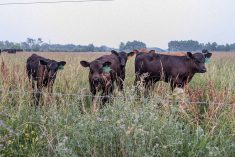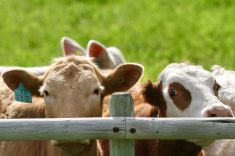PICTURE BUTTE, Alta. – The water pouring out of the taps at Lily Mann’s Turin coffee shop looks like weak tea.
The particles floating in the water eventually settle to the bottom but the brown color remains. She’s hesitant to serve it to customers and she buys bottled water for personal use.
“I’d like to get some water I can use. We’re on water meters and it gets expensive,” she said.
When she and other people# from the area showed their water samples at a public health meeting in Picture Butte, many were later reluctant to sip the water provided at the gathering.
Read Also

U.S. farm group supports supply management
U.S. grassroots farm advocacy group pushing new agriculture legislation that would move towards supply management like Canada has for dairy industry
She’s not the only person to experience this problem in southern Alberta. The water in Turin, Picture Butte and Iron Springs has been in this murky condition for about a year. It appears worse in the spring. Testing has revealed elevated levels of manganese but no one can explain why.
Some people in the area blame the poor water on runoff from intensive livestock operations.
Livestock concentrated
The County of Lethbridge in southern Alberta has the highest concentration of intensive livestock operations in Canada, said Rob Bennett, of Alberta Agriculture.
At 450 farms, some residents say expansion has gone far enough. The Chinook Health Authority wants the county to put a moratorium on further intensive livestock developments.
A standing-room-only crowd at the Picture Butte community hall told local government officials they worry their health is compromised by the concentration of farms.
Some suggested there is a two-tiered water system where urban people get cleaner water than rural and small town Albertans. The dilemma is finding affordable ways for small communities to upgrade their water treatment plants.
Most of the communities in the area receive their water through the irrigation network of canals and reservoirs. Intensive farms are located in the same area because the plentiful water supply irrigates their feed grains, forage crops and delivers water to their farms.
While many recognize the economic spinoffs of irrigation and intensive livestock, they say this kind of farming is nonsustainable if the industry is not forced to be clean.
Paul Hasselback, a Lethbridge physician and vice-president of the Chinook Health Region, said most complaints are about odor but a major concern is over possible water contamination.
The doctor said they don’t have reliable scientific measures to link health problems specifically to agriculture, even though some speculate there is a connection.
The size of the industry is almost overwhelming.
The county is home to 116 beef feedlots, 62 dairies, 63 hog operations and 17 poultry farms.
Since Jan. 1, the county granted 14 permits to allow another 53,500 feedlot cattle, a 150-head farrow to weaning operation, 270 dairy cows and a permit pending for 4,000 feeder pigs.
Code of practice followed
These developments are approved on a municipal basis with input from local health boards and the provincial agriculture and environment departments. The county follows a provincial code of practice that suggests building practices, distance from neighbors, manure storage and farm waste disposal.















